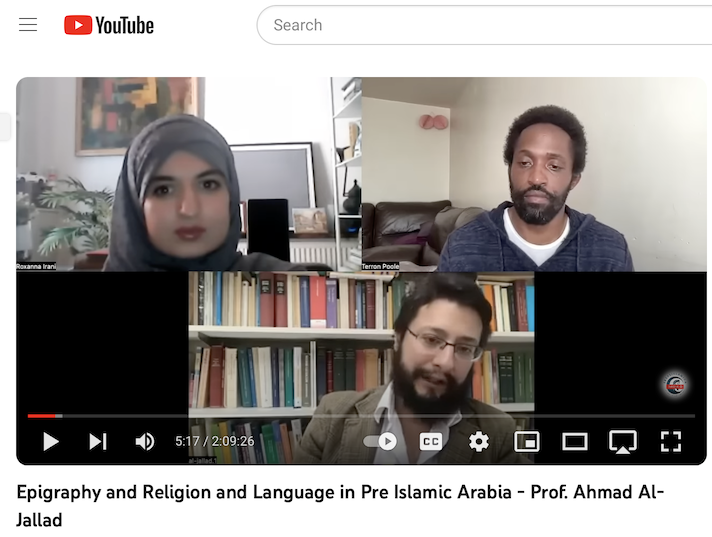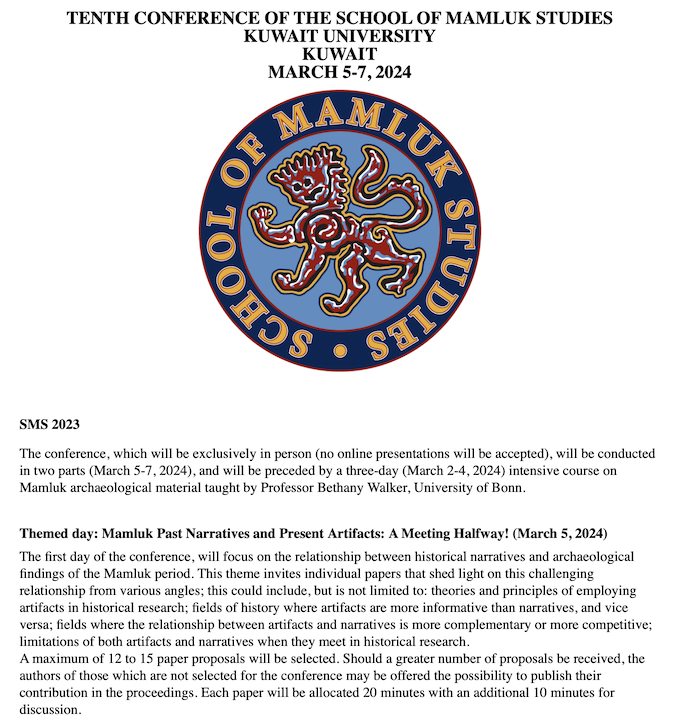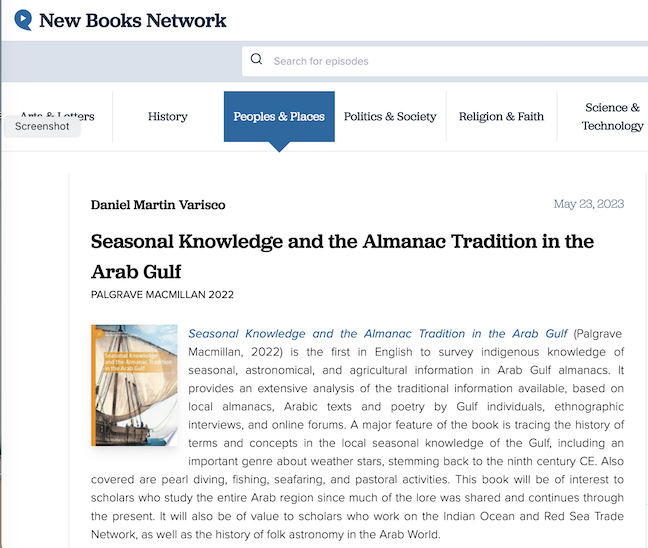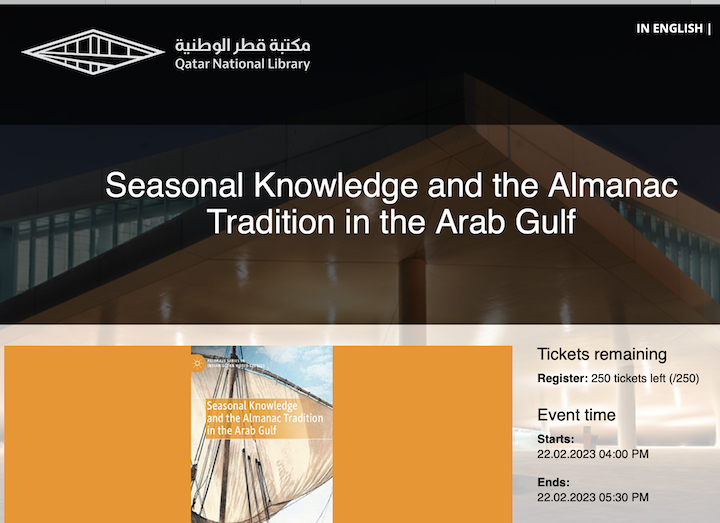
This is an excellent Youtube talk by Ahmad al-Jallad on the evidence from the rock inscriptions and graffiti from the Arabian Peninsula. Also check out his excellent book on religion and ritual in the Safaitic graffiti.

This is an excellent Youtube talk by Ahmad al-Jallad on the evidence from the rock inscriptions and graffiti from the Arabian Peninsula. Also check out his excellent book on religion and ritual in the Safaitic graffiti.

For details, click here.

My podcast with Ahmed AlMaazmi and Tamara Fernando is posted online on the New Books Network.
I will be giving a book launch on my recent book on Gulf almanac lore via Zoom for the Qatar National Library on February 22, 2023. Details about registering for the talk are provided at https://events.qnl.qa/event/opOp5/EN. Please feel free to spread word of the talk. Details on the book are at:https://link.springer.com/book/10.1007/978-3-030-95771-1.


In October, 2022, I participated in the Food Sovereignty Workshop at Ohio State University and discussed the issue of sustainable agriculture and water resource use to improve the opportunity for food sovereignty in Yemen and reduce the staggering amount of need for external food aid. A self-guided pdf tour is available online of the history of food production in Yemen here.

For more information and to register, click here.
By Daniel Martin Varisco
[In 2003 I attended a conference in Rome and gave a paper which was eventually published in Convegno Storia e Cultura dello Yemen in età Islamica, con particolare riferimento al periodo Rasûlide (Roma 30-31 ottobre 2003 (Accademia Nazionale dei Lincei, Fondazione Leone Caetani, 27, pp. 161-174, 2006). As this publication is virtually inaccessible, I am reprinting the paper here (with page numbers to the original indicted in brackets).] The original post on Tabsir was here.
INTRODUCTION AND SOURCES
[p. 161] About seven and a half centuries ago the second Rasulid sultan, al-Malik al-Mu?affar Y?suf ibn ‘Umar, was thrust into power in his youth after his father’s murder, just about the time the Genoan Marco Polo was born. The overlap between the Italian merchant mercenary and mercenary descendant sultan is fraught with irony. Al-Mu?affar, the untested state builder came to power just a decade before the overthrow of the Abbasid caliphate, which had blessed Rasulid rule as a buffer against the Zaydi imams of Yemen’s northern highlands, while the future Italian diplomat set out on his trek only a decade or so after the Mongols had destroyed Baghdad. Polo was destined to serve an aging Kublai Khan, returning to Italy in 1295, the very year that the seventy-year-old-plus Rasulid ruler died. When Polo referred to the immense wealth of the sultan of Aden, “arising from the imposts he lays” in the Indian Ocean trade, he meant al-Mu?affar. Marco Polo and al-Malik al-Mu?affar never met, except in print, but the world that they both embraced was centered on an important trade network linking the Mediterranean and Africa with Persia, India and ultimately the lands of the great Khan.
Fortunately for the Rasulids, the merciless Mongol warriors never reached Yemen, apart from a few individuals who later assisted a Yemeni sultan in compiling a King’s Dictionary also known as the “Rasulid Hexaglot.” (1) [p. 162] Yemen also escaped the incursions of crusading medieval knights, although the legacy of Saladin played a major role in defining its political fortunes until the arrival of the Ottoman garrisons and Portuguese galleons in the sixteenth century. My focus is on the zenith of the Rasulid era near the end of the long reign of al-Mu?affar, the preeminent state-builder of the dynasty. By 1252 he consolidated his hold over the coastal zone (Tih?ma), southern highlands and Aden, as well as achieving periodic control over ?an?’, thus driving the Zaydi imams back to their firm base in ?a‘da. The sultan’s forces in the late 1270s took control, by land and by sea, of the important southern harbors at al-Shi?r and Dhofar, two important sailing venues along the trade route to the Persian Gulf and India. In 682/1283, despite the Zaydi loyalties of many of the tribes, al-Mu?affar was able to briefly take hold of ?a‘da, even striking coins there. Military success led to increased diplomatic recognition for the Rasulids; later delegations are described in the chronicles as arriving from Persia, Oman, India and China. Fortunately, al-Mu?affar was an avid patron of architecture and learning, so that the material and written records of Rasulid activities are quite extensive. (2)
My paper is on the state of Yemeni agriculture near the end of al-Mu?affar’s reign, when his son al-Malik al-Ashraf ‘Umar wrote a major agricultural treatise entitled Mil? al-mal??a and included a detailed agricultural almanac in his astronomical compendium, al-Tab?ira f? ‘ilm al-nuj?m. (3) Perhaps the most valuable resource for the history of Yemen’s internal production and external trade at the close of the 7th/13th century is a compilation made for the court archives of al-Mu?affar. This is probably best styled, in English, a register, a daftar which documents customs, taxes, duties, state finances and production data for the areas under Rasulid control, most notably the commerce through the port of Aden. In this sense, it is a Rasulid “Doomsday Book,” a record of mundane matters that provides a far better insight on the economics and administration of Yemen at the time than any of the surviving historical chronicles. Internal dates indicate most of the information is based on field reports from 1292-96. Yemeni historian Mu?ammad ‘Abd al-Ra??m J?zim has recently edited and annotated this [p. 163] important text for the Centre français d’Archaeologie et de Sciences Sociales de Sanaa.(4)
FOOTNOTES:
(1) This is a unique Rasulid hexaglot, compiled in the 1370s and published in P. GOLDEN 2000. The Mongol dialect entries are mostly from the Il-khânid era.
(2) A fuller account of the achievements of al-Mu?affar is provided in VARISCO 1993a, pp. 14-23.
(3) For a detailed analysis of al-Ashraf’s agricultural almanac, see VARISCO 1994. See also VARISCO 2002, pp. 323-351.
(4) J?ZIM 2003.
to be continued …
The references for the whole paper are indicated below:
REFERENCES
Al-Akwa‘, Mu?ammad
1971 al-Yaman al-kha?r?’ mahd al-?a??ra. Cairo: Ma?ba‘at al-Sa‘?da.
Gingrich, Andre and J. Heiss. 1986. Beiträge zur Ethnographie der Provinz Sa‘dah. (Nordjemen). Sitz. Akad. d. Wiss. Phil-hist. Kl, vol. 462, Vienna.
Golden, Peter
2000 The King’s Dictionary: The Ras?lid Hexaglot: Fourteenth Century Vocabularies in Arabic, Persian, Turkic, Greek, Armenian and Mongol. Leiden: Brill.
Ibn Ba????a
1980. Ri?lat Ibn Ba????a. Beirut: D?r Bayr?t li-al-?ib?‘a wa-al-Nashr.
Ibn al-Muj?wir, Jam?l al-D?n Y?suf (died 690/1291)
1954 ?ifat bil?d al-Yaman wa-Makka wa-ba‘? al-Hij?z al-musamm?t ta’r?kh al-mustab?ir. 2 vols. Edited by Oscar Löfgren. Leiden: Brill.
Ibn S?da, ?asan
1965 al-Mukha??a?. 17 volumes. Beirut.
Ibn Wa?shiyya
1993-95 Kit?b al-Fil??a al-Naba?iyya. Edited by T. Fahd. Damascus: Institut Français de Damas.
al-Khazraj?, Ab? al-?asan ‘Al? (died 812/1410)
1906-18 The Pearl Strings: A History of the Resuliyy Dynasty of Yemen. Edited by J. Redhouse. 5 volumes. London: Luzac and Company.
Varisco, Daniel Martin
1993a The Agricultural Marker Stars in Yemeni Folklore. Asian Folklore Studies 52:120-142.
1993b Texts and Pretexts: The Unity of the Rasulid State under al-Malik al-Mu?affar. Revue du Monde Musulman et de la Méditerranée 67 (1993):14-23.
1994 Medieval Agriculture and Islamic Science: The Almanac of a Yemeni Sultan. Seattle: University of Washington Press.
2002 Agriculture in Rasulid Zab?d. In J. F. Healey and V. Porter, editors, Studies on Arabia in Honour of Professor G. Rex Smith, 323-351. Oxford: Oxford University Press.

Check out an interesting podcast on Muslim writing on science fiction.